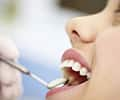Anatomy of the Platysma Muscle
You can find this broad sheath of muscle by resting your fingers across your neck, just above your collarbone, and pulling your mouth into a deep smile. You'll feel it activate in your neck as it contracts. A paper in the Journal of Craniofacial Surgery (JCS) explains that the muscle begins in your upper chest at your collarbone. From there, it extends upward through the front of your neck and attaches to the skin and connective tissue in your lower face and cheeks. The cervical and mandibular branches of the facial nerve supply movement to this muscle, according to the JCS paper.
Function in Your Neck and Face
The platysma is a superficial neck muscle, as StatPearls explains, which means it's located close to your skin. Because of its location over the bottom jaw (also known as the mandible) and the skin in your lower face, it plays a role in opening your jaw — but as the JCS paper notes, its most important job is helping you make facial expressions. The platysma is responsible for drawing the skin around the lower part of your mouth down or out, which creases the skin in your lower face, according to the Loyola University Medical Education Network.
Without this muscle, you might have a hard time sipping beverages, kissing, frowning or making any distinct facial movement that uses your lower mouth. Several other expressions that use the mouth, such as surprise, confusion or displeasure, also wouldn't be achievable without this muscle.
To some extent, this muscle aids in your daily oral care since the platysma helps you hold certain positions with your mouth when you brush. During brushing, regular cleanings or dental treatment, it helps you draw your cheeks back away from your mouth while your jaw is fully lowered so you or your dentist can reach your back teeth.
The Platysma and Cosmetic Surgery
As you age, the platysma can shorten and thin, explains the JCS paper. This makes it important in treating sagging neck skin that can develop over time as your skin looses elasticity. Per the American Society of Plastic Surgeons, during a neck lift procedure, a surgeon will often target this muscle to tighten it.
To keep this muscle in good shape, you might want to give facial and neck exercises a try. Though Harvard Medical School notes that there are no scientific studies that document the effectiveness of these workouts, activating this muscle may help it feel firmer.
It's common to feel somewhat sore if you've held your mouth or neck in certain positions for a period of time, such as when exercising or during a dental visit. However, if you notice pronounced soreness in the area, it's always best to seek out your doctor or dentist.
Oral Care Center articles are reviewed by an oral health medical professional. This information is for educational purposes only. This content is not intended to be a substitute for professional medical advice, diagnosis or treatment. Always seek the advice of your dentist, physician or other qualified healthcare provider.
ORAL HEALTH QUIZ
What's behind your smile?
Take our Oral Health assessment to get the most from your oral care routine
ORAL HEALTH QUIZ
What's behind your smile?
Take our Oral Health assessment to get the most from your oral care routine
Join Us
Get the best of your oral health routine and take it to the next level with expert advice, recommendations, products and solutions and special offers.
Join Us
Get the best of your oral health routine and take it to the next level with expert advice, recommendations, products and solutions and special offers.















